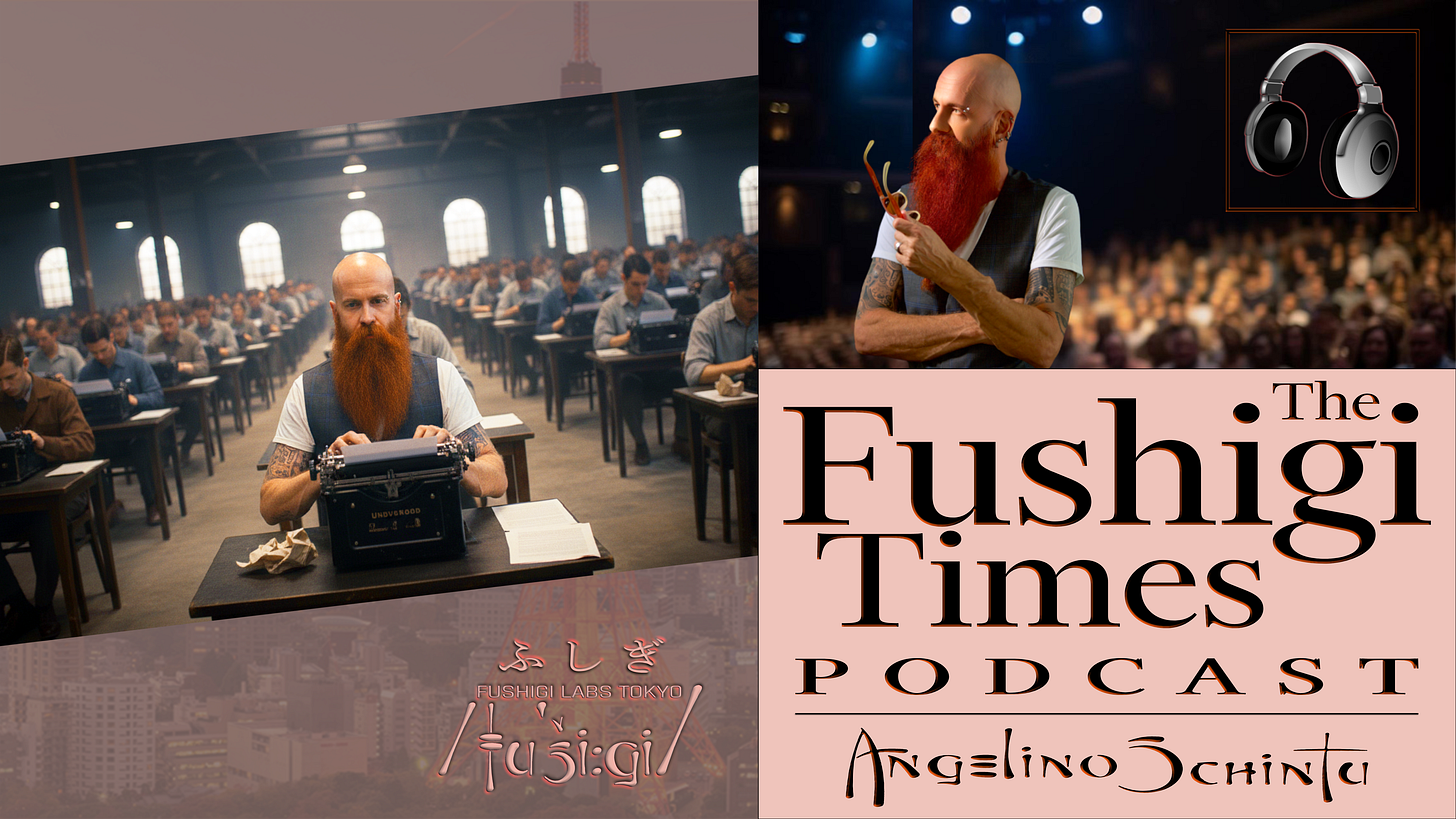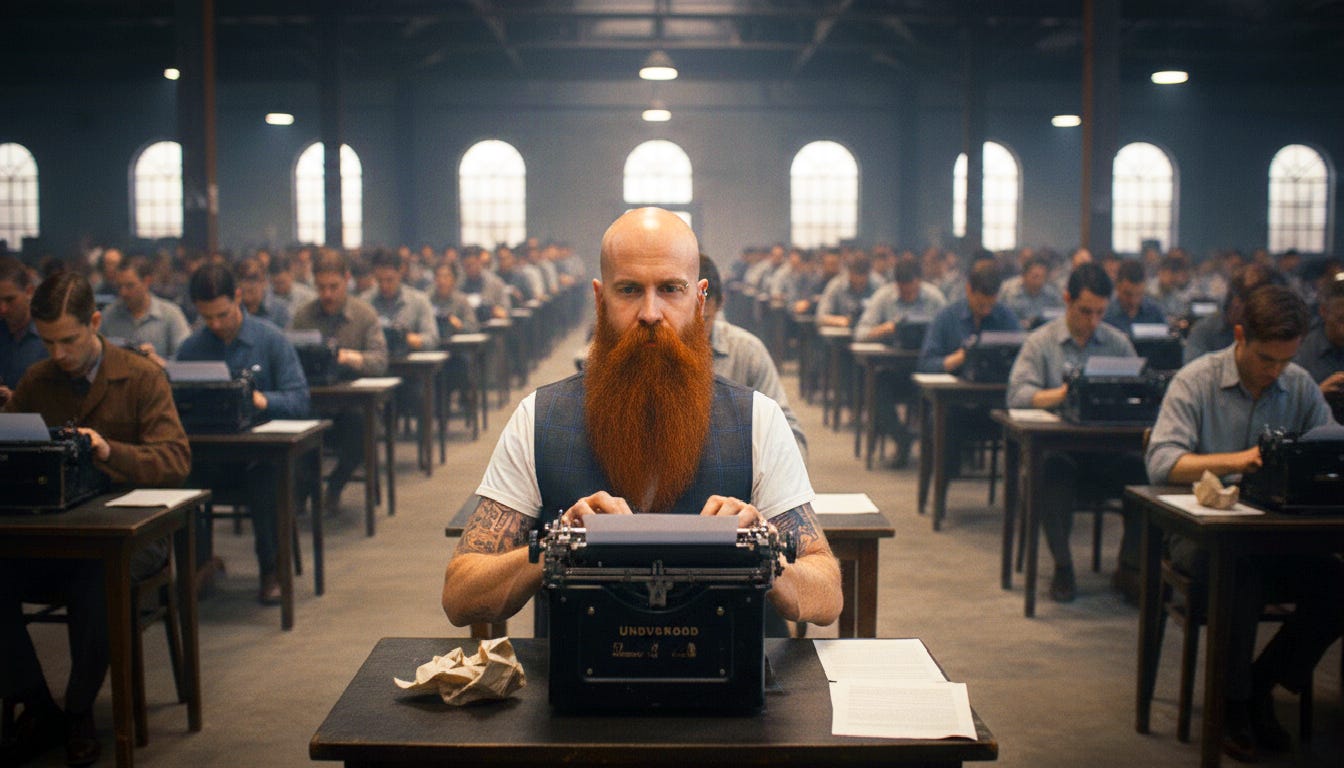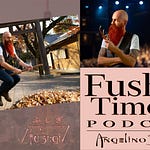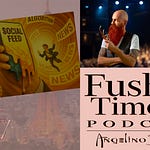This Slow Media content is supported by [YOUR ORGANISATION NAME HERE] and is best viewed in a browser.
In This Episode
Hundreds of typists in a secret warehouse turn intelligence into hardcopy, proving that even in a world of AI, humans still matter.
The Typewriter Revolution is real — Gen X rediscovers old friends, Gen Z discovers them for the first time, and everyone’s suddenly in love with the clacking, transferring ink to paper.
In these fushigi times, slowing down becomes a small act of defiance, a way to reclaim attention, memory, and the simple pleasure of letting words take shape on the page.
Scroll down to read the FULL article
Production Credits
Creator / Writer / Presenter: Angelino Schintu
Produced, Recorded & Engineered at: Fushigi Labs Tokyo
Opening & Closing Voice / Audio Production: Thomas Kinkaid
Theme Music: Original composition Fushigi by Andrew P Partington
PARTNERSHIP OPPORTUNITY
This Slow Media content is supported by [YOUR ORGANISATION NAME HERE]
The Fushigi Times is committed to offering thoughtful, independent, reality-grounded perspectives on global affairs, cultural explorations, and creative thought—made possible with the occasional support from like-minded partners.
...brief Sponsor description...
If there’s a friend, colleague, or fellow traveller you think might enjoy listening to this podcast, consider sending a link their way — subscribing costs nothing, the content is free forever, and it helps keep this Slow Media project alive and growing.
Control or Be Controlled: An Impossible Mission?
Hundreds of keys striking paper, each echoing across a cavernous warehouse in a top-secret location, fingers moving in manic yet precise choreography. It is, in every sense, absurdly theatrical.
The scene is from Mission: Impossible – Dead Reckoning. Almost three hours of Tom Cruise-as-Ethan Hunt blockbuster action revealing a moment of bizarre brilliance:
Intelligence pulled from a maze of supposedly secret global computer systems, transcribed by human hands onto paper.
Not AI. Not imagined. Real humans, tangible ink, as permanent as it can be paper.
And yet, in all that cinematic exaggeration, there is truth lurking like a real-life spy under dim streetlamps, in the shadow of a café awning, taking notes while pretending to sip espresso. It is not meant as fearmongering or an invitation to strap yourself into a bunker for the next decade. It is a meditation on pace, control, and human agency in a world where speed, convenience, and artificial intelligence seem to have taken over like over-sugar-hyped toddlers in a candy store.
I have been thinking a lot about how we measure control. In our work, we are glued to screens, chasing updates, email responses, video calls, and the occasional existential dread ping.
And if intelligence — human or artificial — is always faster than our ability to process it, then we are not living. We are reacting.
Watching this scene, I was struck by a paradox. Slowing down, typing each letter with intention, can feel revolutionary, almost subversive, in a world addicted to speed. This episode of The Fushigi Times Podcast is about recognising that slow media is not old-fashioned, boring, or something your parents or grandparents used to do while wearing cardigans. It is a pre-emptive strategy. If we do not deliberately curate our engagement with technology, we risk being swept along, our attention manipulated, our memory overwritten, and our control quietly eroded.
And that, in the end, is scarier than any cinematic AI antagonist throwing fireballs in your living room.
The Rhythm of the Typewriter
A typewriter is not a machine in the modern sense. It is an instrument, a percussion orchestra of chaos and beauty. Every keystroke matters. Every carriage return is a dramatic pause worthy of its own cinematic score. Miss a keystroke, and there is no magical backspace erasing your sins. You must face the imperfection, adapt, and sometimes curse gently at the universe.
Contrast this with flick-scroll feeds, attention diluted across news bites, algorithmically curated videos, and real-time updates designed to make your emotions perform an Olympic sprint.
One is immersive and sensory, the other ephemeral and engineered for distraction. Choosing the typewriter is consciously walking the slow path. It is a form of rebellion.
Over the past few weeks, I have reinstated typewriting as a daily ritual. Morning drafts, handwritten letters, notes-to-self, podcast ideas — all the glamorous behind-the-scenes chaos you never see. These small acts anchor the mind, build memory, and instill discipline.
There is humour here. The clattering of keys is far from silent. Neighbours might imagine a tiny printing press operating in my studio.
I like to picture them peeking through the blinds, eyes wide, imagining industrial espionage. But I love the sound. It is beautiful. It is deliberate. It is very human.
Adopting this rhythmic tempo, I have noticed a recalibration of my attention. Words linger, thoughts deepen, ideas do not vanish at the ping of a notification. It is tactile, temporal, and immensely satisfying. For me, the typewriter is not nostalgia. It is practical, neurological, and quietly radical — a daily exercise in reclaiming control over speed, tempo, and thought in an increasingly accelerated digital environment.
From Flick-Scroll to Finger-Tap: The Medium Shapes the Mind
Despite mostly leaving social media, I’ve discovered that digital entanglement is surprisingly clingy. Work demands email replies, video conferences, and instant messaging. Alone, these tools are innocent enough. Together, they form a relentless torrent of attention-draining activity.
And here’s a question: how does the medium through which information flows dictate the way we think? Feeds, alerts, and push notifications fragment attention and reduce patience.
People get annoyed if you don’t respond almost immediately — as if the wellbeing of the universe itself were waiting for your thumb tap, without which the time–space continuum might be irreversibly disrupted!
By contrast, typing on a mechanical typewriter, writing a letter by hand, or reading a printed newspaper forces the mind to slow down, process, and synthesise.
And you’re not imagining it — typewriters are making a comeback. For those of us who grew up banging out memos, letters and broadcast news copy on clunky machines, returning to the typewriter isn’t nostalgia; it’s basic comfort. We remember what it’s like to have a machine that actually makes you slow down.
For Gen Z and younger men and women, who mostly know keyboards and tap screens as the gateway to TikTok, the typewriter is a curious, slightly rebellious novelty.
And this isn’t just my personal bias: publications like Typewriters.com, Saving Advice, and Verified Market Reports have noted a resurgence in analog writing, with cafés, workshops, and even online communities celebrating the medium.
The younger generations are discovering, with wide-eyed fascination, that writing can be deliberate, noisy, and joyously analog.
I now deliberately segregate parts of my workflow and times of reflection. For research, screens remain indispensable. But drafting, outlining, and thinking happen on paper. Each session begins with intention: what’s the purpose? What’s essential? What can wait?
These choices are subtle but transformative. They highlight the difference between reflexive consumption and deliberate creation — between being herded by technology and directing it with flair, occasionally punctuated by the clack sounds of a well-worn typebar.
Slow media is therefore not just slow for its own sake. It’s active. It’s conscious. It is the medium’s stance against an environment engineered for reactive, emotional, and often mindless interaction.
And I firmly believe the medium is inseparable from the message: tactile, deliberate media cultivates deliberate thought. And yes, sometimes it cultivates accidental ink splats, minor paper jams, and a sense of triumphant absurdity.
Embracing the Tactile as a Form of Resistance
In an era dominated by ephemeral screens, tactile engagement is a radical act. Mechanical typewriters, ink pens, printed books — they demand more than cursory interaction. They require attention, persistence, and patience. And by doing so, they resist the dopamine-engineered speed of digital media.
The tactile is a form of resistance against external and internal pressures. It is not merely nostalgic; it is strategic.
Every keystroke, every letter, is a physical record of thought. Memory is strengthened. Ideas are preserved. Reflection is unavoidable.
I have instituted these rituals. Notes are handwritten, drafts are typed, letters mailed. Even the act of choosing which pen or paper to use — my beloved Bortoletti glass pen included — becomes an exercise in conscious living. Modest interventions, yes, but transformative, creating anchors in an environment designed to fragment thought.
And humour sneaks in. Writing long letters in 2025 feels absurd. Yet it is joyful and effective. The tangible act of creation slows perception, allows reflection, and builds resilience in a world increasingly dictated by speed.
The Typewriter Revolution
Across the globe, the typewriter is making a quiet comeback. Cafés now feature clacking keys as ambient background noise, not just the hiss of espresso machines. For my generation, the ones who grew up with typewriters as the only formal communication apart from handwriting, returning to it is comforting and familiar. Nostalgia is part of it, but there is something deeper — a return to the tools we understand, a reclaiming of process.
For Gen Z and younger generations, this is entirely new. They have never pressed a typewriter key, never felt the deliberate resistance of paper under metal, never cursed at a sticky ribbon mid-sentence. They are discovering a tangible form of creation that cannot be auto-corrected or deleted in a cloud somewhere. And for many, the charm is intoxicating. There is a romance to this clattering ritual that digital interfaces just cannot replicate.
Watching this new generation experiment with typewriters, I can’t help but chuckle.
They peer at the keys like archeologists at an ancient relic, occasionally hitting the wrong row and recoiling in horror.
Yet they persist. And good on ‘em too.
This is the typewriter revolution. It is revolutionary, and it is absolutely wonderful.
Your Mission, Should You Choose to Survive AI
AI is neither villain nor saviour. It is a tool and a lens through which we confront our own agency. Dead Reckoning dramatises a scenario in which intelligence networks, manipulated by AI with the complicity of some very nasty people, threaten to overtake human control. Reality is not quite so fantastical, at least not yet, but the principle resonates.
Delegating judgement, attention, and synthesis entirely to algorithms is alluring. Efficiency, precision, speed. Yet each convenience carries a hidden cost. AI does not intend to control us—we think. Humans often relinquish that willingly, drawn by promises of optimisation and ease.
In practice, I limit AI-assisted work to discrete, controlled tasks. It curates data, summarises, automates repetitive work. But decisions, synthesis, and creative thought must remain human.
It is a deliberate partnership, not abdication. Slowness is preserved not by rejecting AI, but by setting boundaries: when, where, and how it participates.
Humour remains essential. Imagining an AI criticising my syntax while I type is oddly comforting. It reminds me that even if technology is advanced, human judgement and tactile engagement retain irreplaceable value.
Work and Play in the Fushigi Times Blue Zone
Country-Sea, Japan, is a world measured by tides, rice fields, and some pretty amazing sunrises over Onjuku Beach. The work rhythm — occasional travel into Tokyo, meetings, reporting — is harmonised against the slow coastal life we have chosen. Daily walks, long meals, and observation of seasonal changes act as anchors in a world designed to accelerate attention.
Slow media is therefore a lived, not theoretical, practice. Reading the FT Weekend over brunch on Sundays, sketching ideas on paper before touching a screen, observing the natural tempo of waves, wind, and sunlight — these rituals counterbalance the urgency of travel, emails, and meetings.
They are proof that slowness can coexist with productivity. These practices are practical, not ornamental.
They reduce cognitive load, build memory, and foster reflection. Blue Zone habits — long meals, social engagement, faith practices, physical activity — integrate seamlessly with slow media, illustrating that mental and physical rhythms are inseparable.
Digital Minimalism Without Digital Abstinence
Slow media is not anti-technology. Screens, software, and AI can be allies if boundaries are set. The art is curation, not abstinence.
In daily life, this means a deliberate choreography between devices and analogue tools. Work, reporting, research, and communications still require digital engagement.
Flight bookings, press releases, media production, emails, videoconferences — unavoidable. The difference lies in intentionality. Notifications are off by default. Incoming messages are met with conscious assessment, not with reflexive anxiety.
Social media, long demonised as the ultimate attention vampire, is handled similarly. I do not scroll endlessly.
I engage selectively with curated sources, journals, newsletters, colleagues, and occasionally the absurd corners of the internet. The rest is ignored.
Humour helps. Picture a room full of colleagues swiping, tapping, scrolling, and there I am, a lone figure with my 100-year-old Underwood Portable 3-Bank typewriter, clacking away in defiance of modernity. Functional absurdity, if you will.
The Sensory Paradox: Sound, Sight, and Human Attention
Sound is underappreciated as a vector of cognition. The clack of typewriter keys, the rustle of paper, the subtle scratch of pen on notebook — these are anchors, not distractions. They draw attention into the present.
In Dead Reckoning, the visual of hundreds of typists racing to transcribe intelligence is comically absurd, yet it illustrates the paradox: slowing attention through sensory engagement preserves control over your own mind and decisions.
Incorporating tactile, sensory stimuli into work and reflection is transformative. I time typewriting sessions with natural light, minimal noise.
The weight of the pen, the resistance of paper, the deliberate feedback of a typewriter key all act as attention anchors.
Watching someone manually type information available digitally in milliseconds seems ridiculous. Yet that absurdity is the point. Slowing allows us to reclaim perception and reassert control over our thoughts and work.
The Practicality of Slowing Down
Slow media is not a philosophy confined to journals or coffee-table essays. It manifests in small daily routines, each act anchoring cognition and fostering memory.
Mornings for writing, afternoons for reading, evenings for reflection. Notes, letters, typewritten drafts create tangible records, immune to deletion, algorithmic suppression, or accidental loss. Digital-only work evaporates, leaving fleeting traces. Balancing these worlds is humorous, yet a constant reminder of the human element that digital machines cannot replicate.
Slow media is survival, clarity, and efficacy wrapped into everyday practice. It is the art of making time for reflection and reclaiming control over mental and emotional bandwidth.
AI, Typewriters, and the Art of Keeping Your Mind
AI’s capabilities are awe-inspiring, but unchecked reliance upon on it can become a threat. Dead Reckoning dramatizes a worst-case scenario: an intelligence network leveraged by AI, co-opted by humans, imposing control. The cinematic exaggeration is absurd, yes, but it’s also unnervingly plausible.
It asks a question that is part sci-fi, part existential panic: what if AI becomes so powerful, so ubiquitous, that our only way to truly communicate, preserve thought, or assert our own control is to return to typewriters, pens and ink, and handwritten letters?
Curation and boundary-setting are the antidotes. No matter how advanced, AI cannot inhabit the tactile, reflective, and idiosyncratic world of human thought.
Modern slow media is not technophobia. It is a commitment to judgement, reflection, and deliberate engagement. AI may assist, but surrendering one’s mind is absolutely out of the question.
And so we return to the tactile. The clack of typewriter keys, the weight of ink on the nib of my Bortoletti glass pen, the friction of paper under your hand — these are tools of self-preservation.
Ideas linger longer, connections emerge more clearly, and decision-making improves. Writing by hand or on a typewriter demands intentionality, focus, and discipline, reinforcing memory and self-awareness.
In the improbable, slightly cinematic future where screens are enslaved to AI and attention is a luxury, this tactile resistance could be our only lifeline.
The tactile bridges mind and matter, thought and expression, reflection and action. It reminds us that human experience is inseparable from deliberate engagement with the world, whether via typewriter, fountain pen, or any medium that insists we slow down.
Dead Reckoning in Daily Life: The Slow Media Challenge
Slow media is a series of deliberate choices. Each day, I choose which tools to engage, when to pause, and how to structure time. Typewriters, pens, and paper form the backbone, digital tools serve a disciplined purpose.
Dead Reckoning becomes both metaphor and practice: navigation through the turbulent currents of technology, information, and AI. The map is drawn by deliberate, tactile, reflective engagement. The compass is attention. The destination is control, presence, and clarity.
This is slow media in action, my small rebellion against speed, distraction, and the digital rush.
Yes, it takes more time. Yes, it is more deliberate. But it is worth it. That extra time gives space to think through each word, each phrase and idea, in a more considered way.
And by the way, what you’re listening to (or reading) now is slow media in practice. Drafted with a fountain pen, typed on a mechanical typewriter, scanned, corrected, recorded, edited, and uploaded.
Your mission, should you choose to accept it, is to slow down — to notice, to type or write with care. Should you (or anyone on your team) be discovered, you will not be disavowed. And this message will not self-destruct in five seconds. Good luck!
📢Want to rebroadcast this?
This original content is part of our Slow Media canon — carefully crafted, independently produced. If you’d like to license, rebroadcast, or syndicate this podcast, let’s talk. We’re open to collaboration — as long as it stays thoughtful, grounded, properly credited… and paid for.
Slow Media Needs Slow Money…















